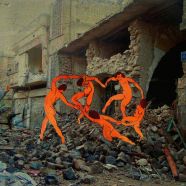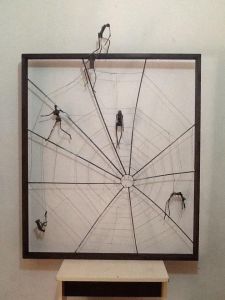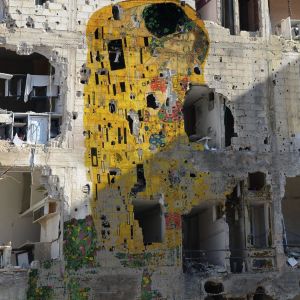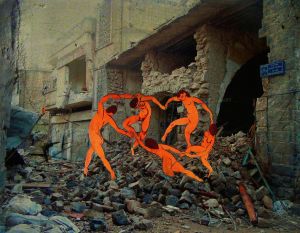The Queens of Syria
On 18 March 2011, after forty years of terrorized silence, Syrians stood up to the draconian rule of the Assad dynasty. Unlike the other Arab Spring revolutionaries who ousted entrenched leaders, the Syrians did not succeed in dislodging their tyrant. With the most powerful military and secret service apparatus in the region, and international support from Shiite neighbors, Bashar Assad has clung to power. And yet, despite the virulence of his repression, four years later the survivors keep on demonstrating throughout the country.
The costs of this revolution have been enormous: 450,000 killed, 11 million internally displaced, unknown numbers disappeared, and almost five million escaping the country with nothing more than the clothes on their backs. More than one million Syrians have taken refuge in Lebanon, a country of five million inhabitants; Turkey has taken in two million; Jordan over 630,000; Germany, with a population of 81 million, has opened its doors to almost 500,000 Syrians; and the United States with 310 million souls has taken in a paltry 2,715 Syrian refugees with a pledge to take in 10,000 this year.
Syrians of all ages, classes, and professions who fled to Jordan found themselves either in camps like Zaatari, with its icy wet winters and burning dry summers, or in certain quarters of the capital city of Amman where they compete with the more established Iraqi refugees for scarce resources. In Turkey, Syrians scattered into the cities. Many by now are begging on the streets of Istanbul or Ankara, or have found refuge in camps where they are considered “guests” who will overstay their welcome. However, the influx of wealthy Syrians, especially those with businesses in cities adjacent to the borders, like Gaziantep and Kilis, has improved the economy: inflated rents, expensive restaurants, and huge building projects covering many miles of what used to be open countryside. But this boom has turned the Turkish welcome into hostility as less affluent Turks compete with Syrian newcomers for jobs and resent that the Syrian presence has rendered life more expensive.
None of Syria’s neighbors has signed on to the 1951 UN Convention that guarantees refugees asylum, and so their hospitality is morally rather than legally driven. In Lebanon, the situation of Syrian refugees is most precarious because they now make up 25% of the total population; they have outstayed their welcome. Consequently, few find shelter except in refugee camps that were set up in 1948 to house Palestinians fleeing from the new state of Israel. Supposedly temporary, these UN camps set up for Palestinian refugees almost seventy years ago still function today. Palestinians born in these states of exception still await the impossible: a solution to the Israel-Palestine conflict.
So what is it like in these Palestinian enclaves that are providing shelter for Syria’s fleeing population? Take Beirut’s Shatila camp. Like other Palestinian camps, it has grown to accommodate new generations of Palestinians and now Syrian refugees. Vertically. The borders of the 1.3-square-kilometer camp cannot expand, so the only option is to sprawl upward. New floors are added to already unstable structures. Outdoor stairwells crumble under the constant stream of new feet. Sewage flows through back alleys. Seawater flows out of the taps, undrinkable and unusable. Garbage piles high at street corners. Spaghetti-tangled electric wires hang dangerously low. Despite these disastrous conditions and their own destitution, Palestinians here have opened their modest homes to the Syrian refugees. There they wait with little to do; their children are denied access to schools and the future is bleak.
During the past year, the number of Syrians venturing on foot or in leaky boats across and beyond the borders of neighboring countries has increased exponentially. The hostility they are encountering in Lebanon, Turkey, and Jordan has made life very difficult. Despite the very evident dangers they know they will face, they are risking their own and their families’ lives to get to Europe. The headline attention to Aylan Kurdi, the three year-old Kurdish boy found dead on a Turkish beach in September 2015 broadcast the plight of Syrians so desperate that near certainty of death in the Mediterranean has become preferable to returning home. The violence in Syria has escalated with the convergence of international players, each projecting their own designs and desires on this cradle of civilization. Moreover, the growing power and influence of the Islamic State with its stronghold in the northeastern city of Raqqa has added another lethal element to the out-of-control violence tearing Syria apart.
The misery of Syrians is constantly reported, but what I would like to emphasize now is their less well reported but extraordinary resilience and creativity, both inside the country and outside. “Most of the time,” writes American Reverend William J. Barber, “your greatest vision comes in your darkest night, because it is then, Martin Luther King Jr. said, that you see the stars. Populist movements don’t build when everything is fine. A populist moral vision is a form of dissent that says there’s a better way, there’s a moral way.”1 No matter how chaotic the Syrian situation is today, no matter how dark its night, Syrians still see the stars.
Professional Syrian artists and writers have scattered around the world. In the mountains above Beirut, a Syrian art benefactor has established a center for Syrian refugee artists. Art Residence Aley’s peaceful space gives them time to process what they have been through. In a documentary film about the Residence titled Art of Resilience, one artist commented that ARA had restored the colors in his life after violence at home had reduced everything to black, white, and gray. The ARA website displays artists’ works, and many are priced. The sale of the artists’ works allows them to become self-sufficient and gives them exposure so that they can travel on to a safer, more secure future.2 In the metal installation called Escaping Assad’s Web, Giacometti-like refugees are shown trying to escape the stickiness of the Syrian state’s spider web. The artist, Sari Kiwan, projects the fate of a people desperate to leave the home that has become a terrifying trap. Some are dead, broken-backed, locked forever inside. Others still hope to undo the hold of the wires as they rush toward the borders. One lucky person who has escaped stretches out his hand to pull his companion out of the threads that have already entrapped his legs. Kiwan’s works fill the garden of Art Residence Aley with stories of abandonment but also hope of survival.
Even under the most trying circumstances, many Syrian refugees have asserted life and creativity over defeat. Some have become surprisingly entrepreneurial. In Jordan’s Zaatari camp, refugees have opened over three thousand shops and small businesses. This miserable camp in the middle of nowhere has grown into a shantytown city, Jordan’s fifth largest city. With the help of international volunteers, some refugees produced the colorful “Zaatari Project: Art with Syrian Refugees.” They focus their energies on the children who are at risk of losing their childhood and any chance of a decent future because of lack of education. In addition to attending art and educational workshops, refugee children “participate in the creation of public murals, paint their wheelbarrows and make kites. The project aims to make a difference in the lives of the adult facilitators as well: local artists and educators learn how to organize and lead their own community-based arts and education projects.”3
Uprooted writers encounter specific challenges as they settle uneasily into new places whose languages they do not know. Writing in Berlin, dissident novelist and TV screen writer Nihad Siris told me during a visit to Duke University in March 2015 that he confronts the “disorder” of two worlds constantly interfering with each other. The echoes of bombs in Damascus and Aleppo interrupt the calm of Bach in Berlin. “I write to watch my characters develop in the disorder of my two worlds and to respond to urgent questions that I could not otherwise answer.”4
Theater has provided Syrian women refugees with a forum where trauma can be negotiated, communicated, and performed. Fumbling for language to articulate apparently unprecedented tragedies, some refugee women in Amman and Beirut were surprised to find exactly the right words in stories told long ago. With the help of professional theater directors, Syrian women refugees adapted ancient Greek tragedies to articulate their grief and terror. In the fall of 2013 in Jordan, twenty-five women put on Euripides’s Trojan Women about the Peloponnesian War, written in 415 BC. It narrates the Athenians’ massacre of the Trojans, the rape of women, and their lament for the loss of their land. Using Euripides’s millennial language, the Syrian women could finally express the agony of homelessness and the loss of those dear to them. At the level of catharsis, the play framed the shapelessness of their lives. They could talk eloquently about what they had undergone. The recognition of their experiences in the stories of these heroines turned their experiences into something important, universal. When the words that actors have repeated for millennia came out of their mouths in Arabic and the words were no longer theater but their reality. These women ceased to be victims; they became survivors. Moreover, speaking these words to an audience that recognized the overlap between the classic and the recent trauma turned these women into heroines. Director Yasmin Fedda filmed parts of the play and its rehearsals, interspersing the dramatic scenes with the women telling their stories in miserable apartments somewhere in Amman. The women marveled at the similarity of their tragedies with those of some Greek women who, like them, had witnessed massacres but 2,500 years earlier. Yasmin Fedda filmed the women drawing maps that traced their itinerary through places where they had to drop some of the things they were carrying. At one point, a woman stopped, unable to continue because the intensity of the loss left her speechless. The documentary titled Queens of Syria premiered at the Abu Dhabi Film Festival and in October 2014, Fedda won the Black Pearl Award for best Arab director.5 The film was screened at UNC-Chapel Hill on April 14.
Creativity is vital in times of violence. What has been destroyed must be restored; bricks and mortar and human lives cannot be allowed to crumble into meaningless ruin. In exile in Dubai and now Germany, Tammam ‘Azzam has been working with such ruins. His works aestheticize sites of destruction. For ‘Azzam the Internet is a new space for art that is more direct, free, participatory, and capacious than the canvases he had used before the revolution. Choosing each time a well-known European masterpiece, ‘Azzam digitally superimposes it onto an image of a recently destroyed building in Syria to produce what looks like street art. Two icons fold on top of one another in such a way that they highlight the destruction through their re-visioning of rubble. Both are individually recognizable but in their intericonic relationship they stop the viewer, compel attention and also time in order to make sense of the unfamiliar familiar.
In his 2012 Syria Museum series, ‘Azzam created Freedom Graffiti by superimposing Austrian Gustav Klimt’s The Kiss onto a bombed-out building. The building is still occupied as evidenced by the laundry some desperate survivors have hung on a clothesline spanning the gaping hole in the wall. In his striking juxtaposition of a woman in gold, tiptoeing on a carpet of flowers and held in a passionate embrace with the almost demolished building, ‘Azzam expresses a longing for love in a time of terror. Why did ‘Azzam choose familiar Western art to broadcast his message of survival and defiance? ‘Azzam explained that he wanted to draw a parallel between “the greatest achievements of humanity with the destruction it is also capable of inflicting. Each is particularly relevant to what has befallen Syria. Klimt’s ‘The Kiss’ shows the love and relationship between people, and I have juxtaposed this with the capacity of hate the regime holds for its people.” By projecting “The Kiss” high above the ground floor of the destroyed building, ‘Azzam has suspended the dream as a hope.
‘Azzam’s projection of Henri Matisse’s 1909–10 The Dance II appears joyful. Five naked women and men frolic wildly on rubble and debris in a kind of Grecian dabke dance. Where do these exuberant dancers come from? Who are they? Are they joyous flames leaping out of the fire of destruction to prove that they are still alive? Are they survivors struggling to dance on the rubble, held up by the one steady figure on the left?
And so, those who paint, sing, write, and dance take up their arms and fight in their own way to make sure that their revolution is not coopted or, even worse, aborted. To cite the words of Syrian journalist ‘Ammar al-Mamoun who participated in the “Arab Refugee Crisis in the 21st Century” conference held at Duke University in January 2016: “We must create an alternative revolutionary narrative to contest the media stories of Syrian refugees and victims. We must tell our stories now and circulate them so that they will participate in the collective memory of the revolution.” In a skyped talk from Paris, he insisted on the importance of changing the meaning of refugee from identity to political status. The political status will be shed when the forced migrant is given a chance to contribute her skills to her new community.
The lesson we could draw, here in the safety of the American South, is that refugees may be an unexpected resource, none more so than the highly educated Syrians who could bring their experience and multiple talents. We could counter the arguments of politicians and others who want to make it more difficult for refugees from Syria and Iraq to come to the United States. We could counter the unsubstantiated narrative that even Syrian women and children pose too great a risk to national security, as when Governor Chris Christie said his state would not take in any refugees—“not even orphans under the age of five.”6 When presidential hopefuls rail against Muslims and suggest that there may be Islamic State infiltrators among the few desperate Syrians seeking entry into the United States, we have to remember who founded this country. We have to remember our grandparents, where they came from and why and what they did to “make America great”!
Notes
- William J. Barber, “How to Build a Powerful People’s Movement,” The Nation, July 14, 2014, http://www.thenation.com/article/180322/how-build-powerful-peoples-movement#, accessed 22 July 2014.
- Art Residence Aley’s website is located at www.artresidencealey.com.
- http://joelartista.com/syrian-refugees-the-zaatari-project-jordan/.
- Conversation with Nihad Siris in Durham, NC, 24 March 2015.
- https://www.youtube.com/watch?v=MU6UgtCPTac, 24 February 2015.
- http://www.theguardian.com/us-news/2015/nov/19/house-passes-bill-adding-barriers-for-syrian-and-iraqi-refugees-to-us.











Syrian Guernicas….How long will it take us to understand their messages…..